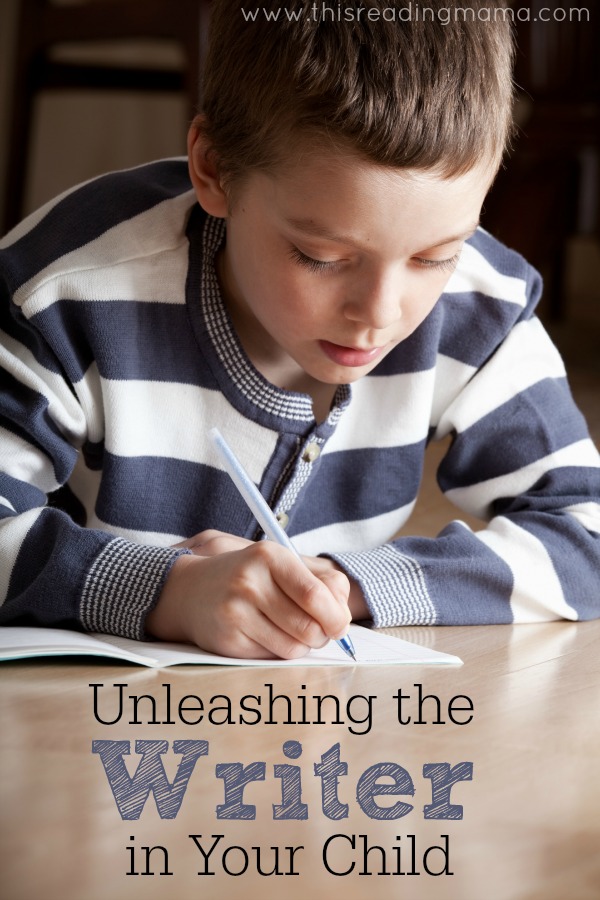
I am SUPER excited to be a part of another 5-day series with iHomeschool Network! And this time, I get to write about one of my favorite subjects (if not my very favorite) to teach: WRITING! Yay! Please Scroll down to see all the topics and links to this series.
This week, I’d like to tackle the subject of writing. Not handwriting. Not spelling. Not writing to a prompt. Not copy work. Just writing. Writing as a CRAFT. Writing as a PROCESS. Writing as a WRITER.
Traditional Writing Instruction vs. Writing as a Craft
The Writer is Given Authority Over His Own Piece
In a traditional setting, writing is very much about the teacher. I give the prompts, I assign the copywork, and I decide what is and is not “correct”. (Please note that I am NOT saying that doing these things as a part of a balanced writing program is wrong.) When writing is seen as a craft, the writer is given lots of choice. Choice to decide his topic, choice to select his words, choice to publish or not publish. Now choice can make things messy. Very messy. But it’s well worth it in the end.
The Student is Seen as an Author
This fits hand-in-hand with the topic above. I find myself using words like, “It’s your choice. You’re the author,” or “You reminded me of {insert author’s name} when you wrote that!” when I work with my first grader at home. The child’s writing is treated as precious and read right along with the classics.
Writing is Not Linear
In the traditional setting, students write in more of a linear way: step 1, step 2, then step 3. While the writing process needs to be introduced in a linear way, once the child understands the process, it is not treated as such. I love Graves’ quote, “Losing balance, regaining it, and going on, is the substance of learning.” Writing truly can be a two steps forward, one step back kind of dance. Writers move ahead, take a step back to revise, move ahead a few steps, fall behind in doubt, move ahead…the process is recursive.
Writing Skills are Learned in Context
In a traditional setting, skills (handwriting, spelling, conventions, etc.) are learned much out of context, treated as a separate subject that writing. When writing time comes, the connection is not easily bridged between the two. While nothing is wrong with teaching handwriting or spelling, writing as a craft reinforces those same skills in context. In the context of writing. Why do we want to write legibly, spell words conventionally or place punctuation in the correct location?
Two main reasons:
1-We care about our message
2-We care about our reader/audience.
When writing is taught as a craft, these two reasons are kept at the forefront. Not always so in the traditional setting.
Writing is Social
In traditional writing instruction, students’ work is not typically shared and celebrated with others. But when writing is treated as a craft, kids interact with a listener. The audience may even drive their writing at times. Lucy Calkins says, “If given the chance to share their pieces with a responsive listener, they often realize they have more to tell and someone who hopes they will tell it.” (The Art of Teaching Writing) She goes on to say that if those listeners interact with and respond to the writer, the writer will soon internalize the reader. {I love that thought.}
Rich with Meaning and Purpose
When students are given authority, treated as authors, taught the writing process, given a reason to care about their writing and audience, and given the ability to interact with an audience about their pieces; writing time can be full of meaning and purpose. In the traditional instruction of worksheets, copy work, and prompt-driven writing; meaning and purpose (aka enjoyment) of writing can be squelched.
“We are teaching the writer, not the writing.” -Lucy Calkins
{photo source}
So, how do you get your child to say YES to writing? How do you UNLEASH THE WRITER in your child? Oh, I’m so excited to explore this topic. We’ll spend the next five days working through the writing process. Here are some of the subjects we’ll cover:
- Day 1: Model Good Writing (modeling, connecting to literature through read alouds, the author’s craft and life)
- Day 2: Choosing a Topic (Writer’s Notebook, quick writes, author’s voice)
- Day 3: Writing a Draft and Preparing for Publication (time to write, invented spelling, keeping the reader in mind, learning from the author)
- Day 4: Publish and Share It! (ideas for publishing work, writing as a social process, authentic audiences to share pieces)
- Day 5: More Writing Tools and Resources (writing strategies beyond Writer’s Workshop, more websites and blog posts related to teaching writing)
More Writing Resources:
- Simple Writing Lessons: a 12-week series, giving you hands-on applicable writing lessons for the primary grades (lots of free printables, too!)
- Preschool & Kindergarten Writing Lessons: a 10-week writing series for Preschoolers and Kindergarten
- 25 Ways to Make Writing Fun
Enjoy teaching!
~Becky

Yea! I am excited too. Writing doesn’t happen a lot around here. Though I don’t mind writing, it is scary for me to try to “teach.” Thanks for this series.
I’m excited for you. I hope the series will empower you to overcome the “scary”. 🙂
I love this!! My son is very inspired by my blog and other writing ventures. He has expressed a desire to be a writer. He is still learning and struggles a bit and I love how this article redirects my focus! I do not want writing to be tedious and I want him to fall in love with the goal of writing…communicating his passions and making an impact! Thank you for sharing this! I will be following!
Yes, yes, yes! You have the perfect venue to model authentic writing! Thank you for stopping by to comment. And thank you for following. 🙂
I read the Art of Teaching Writing when I was an education major in college and it’s the only textbook I have kept and still pull out as a mother/homeschooler to glean from. Ralph Fletcher is also amazing. 🙂
My oldest is four and I’m just not sure how I want to do Writer’s Workshop with her and when I should start…can’t wait to read your posts.
I do love me some Lucy Calkins. It’s definitely NOT a quick read, though. I think I would first start with shared writing (or interactive writing) at age four. I have that in my “Writer’s Notebook” as a topic to cover one of these days on my blog. Thanks for stopping by to share.
Thank you for sharing this series! It’s something I’ve been wanting to work with my own daugher on more. It seems like she’s not writing enough in school, so I know I need to do more at home too. Would love for you to share this on our Sunday After School Linky. Here’s the link http://pinterest.com/melissa_taylor2/writing-ideas-for-kids/
This is awesome! Can’t wait to read it all! I love to teach writing and the writing process is exactly how I taught my third graders to write. Can’t wait to do this with my son.
Wow! I can’t wait to dig in!
I am so glad that I find this article. Very helpful. I have bookmarked the page and will be back for the other articles!
Wow!!! i haven’t thought about author’s craft since I stopped teaching in school…and imagine my giddy pleasure to see, not only books here that I read in college (it was a very inquiry-based/whole language program) but to see my professor’s name! Katie Ray in all her funky hair fun was my prof in college and hers were some of my favorites! i can remember how she sat, perched, reading Missing May to us…..
What a great series! I am a mom of two little guys who blogs about travel, a stint abroad with my kids, and general musings of life and motherhood. I saw your blog through a link from Game4Learning. Thabk you for sharing these great tips on passing on a passion for writing yo our kids! I will be reading!
You’re very welcome!
You’re very welcome. 🙂